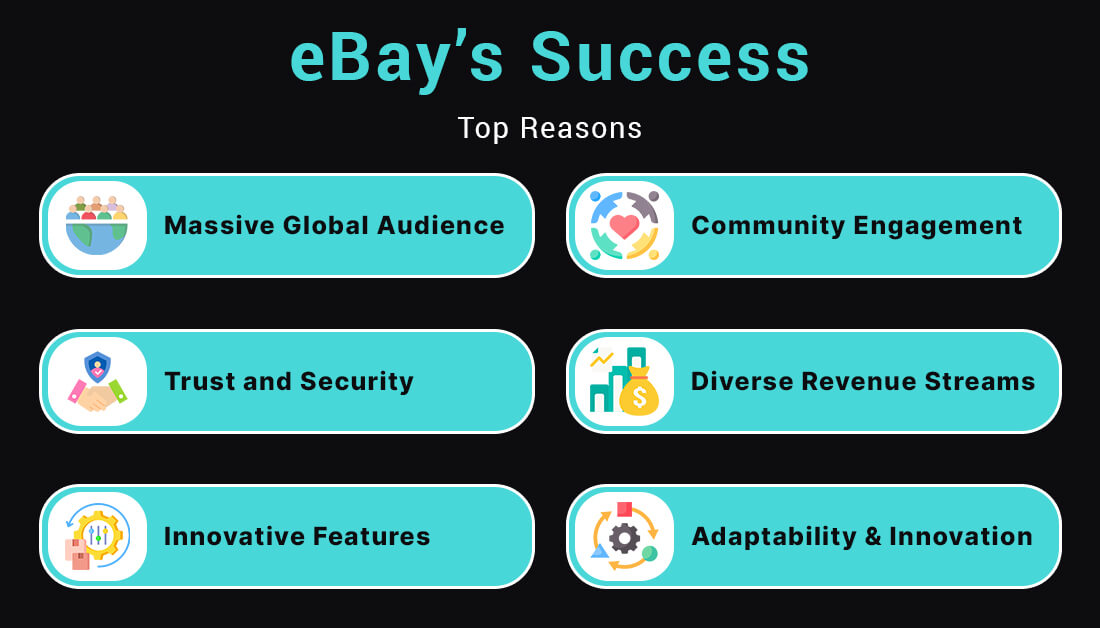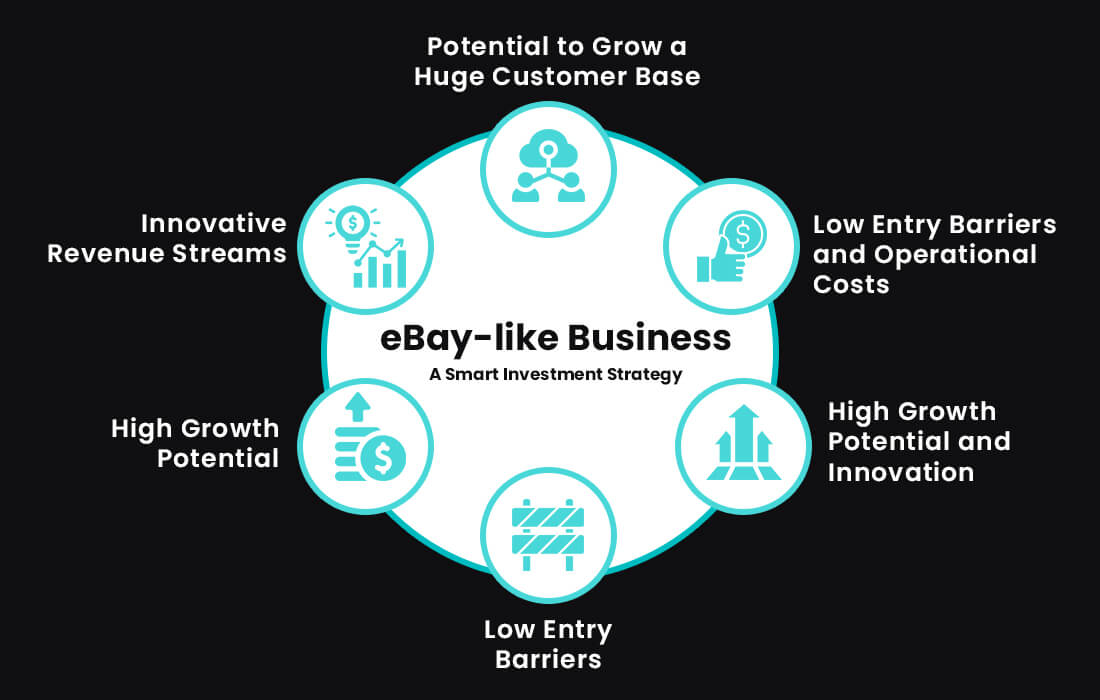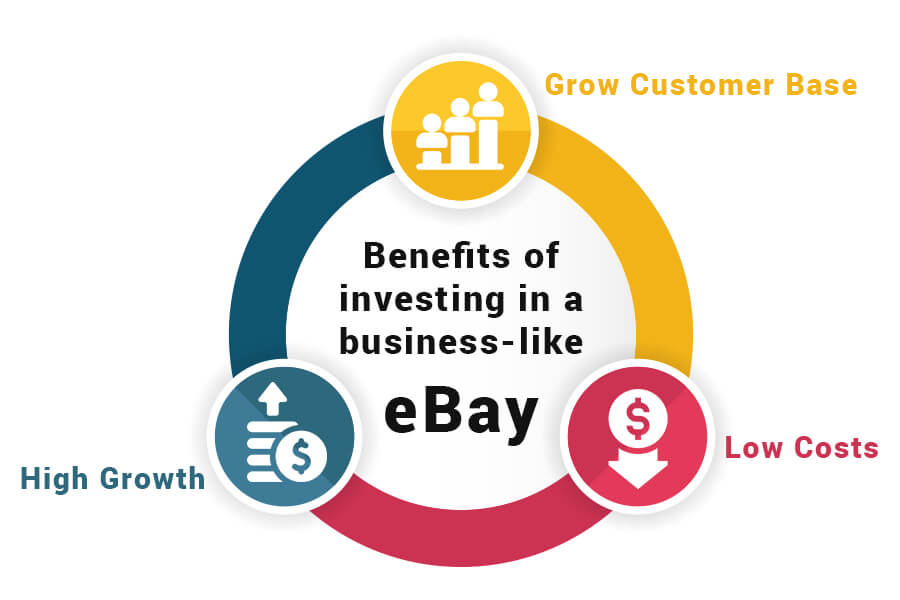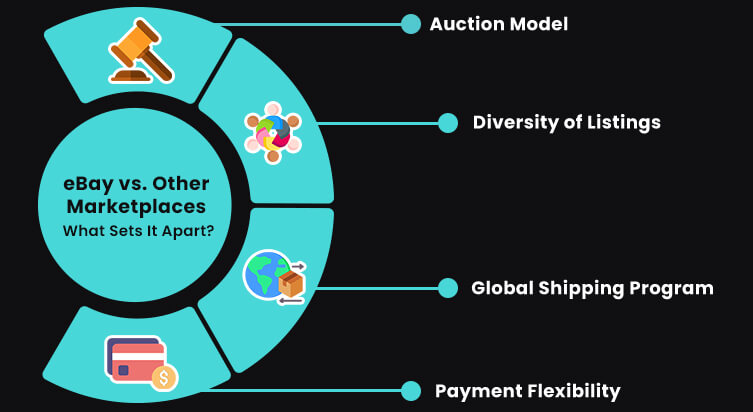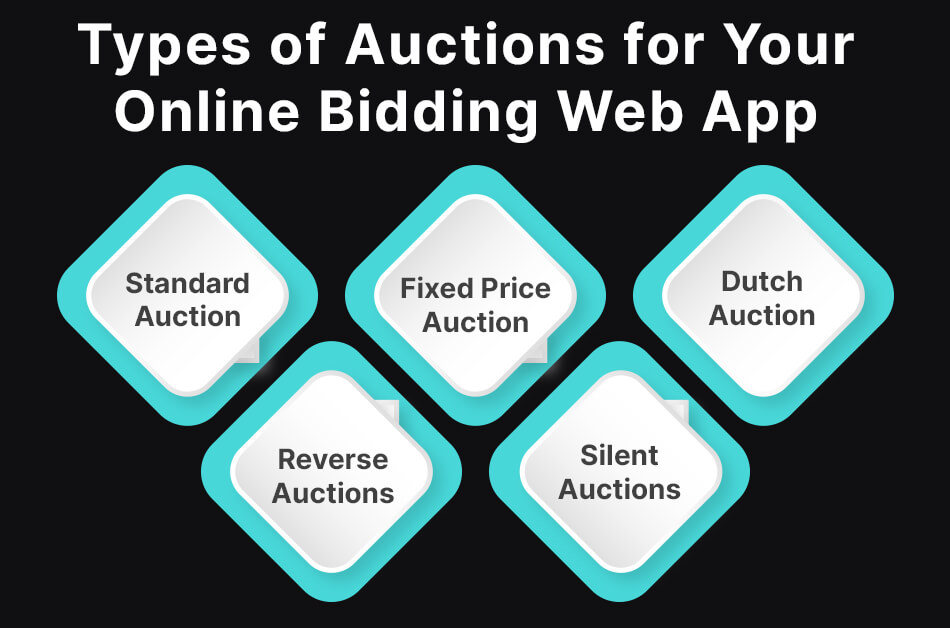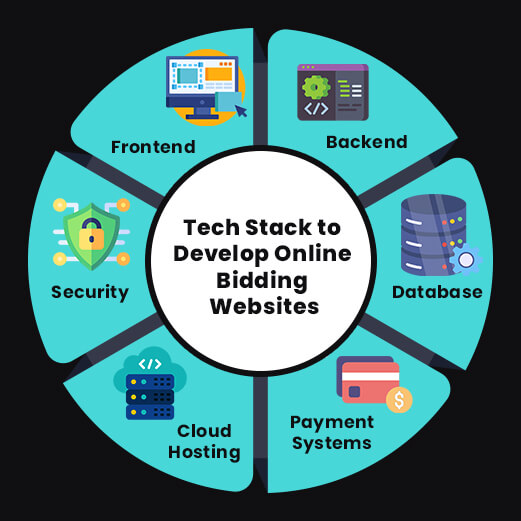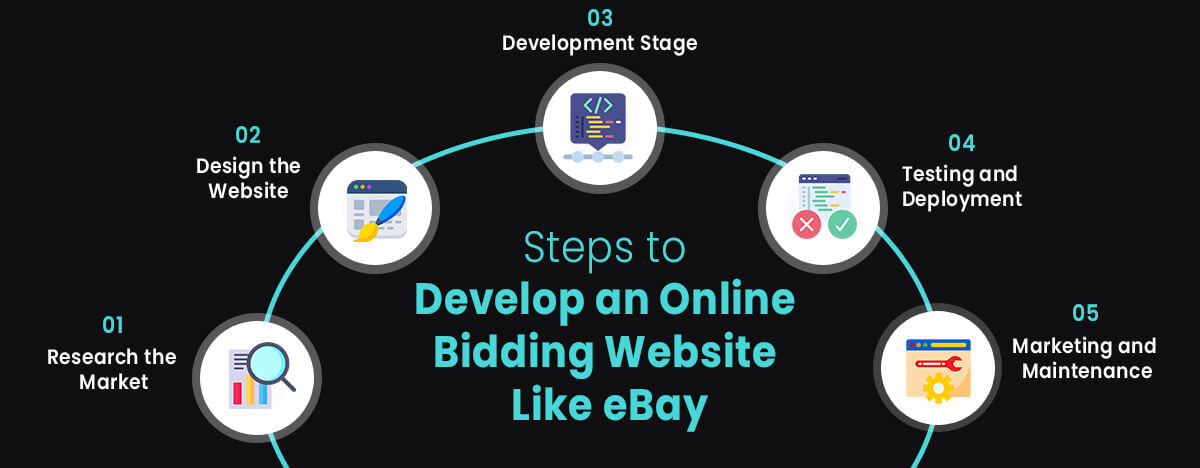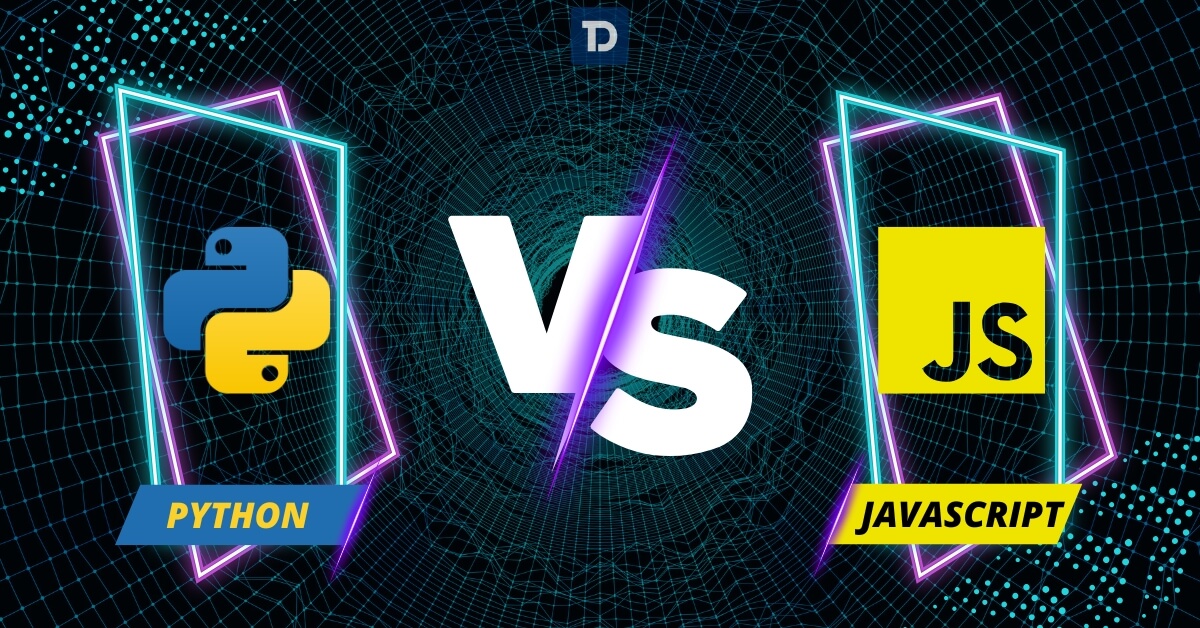
With more than 100 million unique visitors, the auction giant eBay reports a market capitalization worth more than $30.3 billion USD, according to Statista. eBay is still a popular auction website for online bidding as it offers a variety of products at competitive prices, and also convenient payment methods.
What sets eBay apart is its unique auction model, which connects millions of buyers and sellers from all over the world. The platform’s focus on trust, reliability, and security has helped it maintain a loyal user base. With innovative features like AI-driven recommendations, mobile-first designs, and global shipping programs, eBay is not just a marketplace—it’s a thriving global ecosystem.
For entrepreneurs and startups looking to tap into the world of online auctions, building a website like eBay presents a compelling opportunity. With low entry barriers, no need for inventory management, and the potential for rapid scalability, the eBay business model continues to be one of the most attractive in the world of eCommerce.
Creating a successful online auction website requires more than just replicating eBay’s features—it involves strategic planning, choosing the right technology stack, and aligning your platform with business goals. By partnering with the right eCommerce development company, you can turn your vision into reality, ensuring your auction platform provides a seamless and engaging experience for both buyers and sellers.
Let’s explore the key steps and features you’ll need to consider as you start building your own successful auction platform.
Table of Contents
- What Type of Website is eBay?
- What Makes eBay So Successful?
- Why is Investing in an eBay-like Business Worth it?
- What Makes eBay Different from Other Marketplaces?
- How do Online Bidding and Auction Work?
- What are the Types of Auctions you can Include in Your eBay-like Web App?
- The Monetization of Auction Websites for Online Bidding
- Tech Stack to Develop Online Bidding Websites
- Frontend: React.js for Interactive User Experience
- Backend: Node.js for Scalable Server-side Applications
- Database: MongoDB for Flexible Data Handling
- Payment Systems: Stripe, PayPal, and Cryptocurrency Options
- Cloud Hosting: AWS for Scalability and Security
- Security Features: SSL, Two-Factor Authentication (2FA), and Fraud Prevention
- Must-have Features of Online Bidding websites like eBay
- Steps to Develop an Auction Website like eBay for Online Bidding
- Cost to Build an Auction Website like eBay
- Ready to Build a Market-Leading Auction Website
What Type of Website is eBay?
eBay is a global online marketplace primarily focused on auctions, where users can bid on and buy products from various sellers. What sets it apart is its auction-based model, which allows buyers to compete for items, often at lower-than-retail prices. Additionally, eBay features a mix of auctions and fixed-price listings, providing flexibility to both buyers and sellers.
But eBay isn’t just an auction site—it’s an online community platform that connects buyers and sellers worldwide, giving them the tools to engage, review, and rate each other. This creates a high level of trust and a secure environment for online transactions.
What Makes eBay So Successful?
The success of eBay is rooted in its business model, global reach, and focus on user experience. Here’s why eBay continues to thrive:
Massive Global Audience
With over 180 million active buyers, eBay is a platform where vendors and buyers can reach an international audience. This enormous pool of users creates a dynamic marketplace where sellers can reach a broad audience, and buyers have access to a wide variety of products from different parts of the world.
Trust and Security
Trust is a cornerstone of eBay’s business model. The platform has built a reputation for being a secure marketplace that offers buyer protection and reliable transaction processes. The Money-Back Guarantee ensures that buyers can request a refund if the item doesn’t arrive or isn’t as described. Additionally, eBay’s reputation system, which allows users to leave feedback and rate each other, promotes transparency and builds confidence in the platform. This trust-building system encourages both new and repeat users to engage with eBay regularly.
Innovative Features
eBay’s success is also a result of its continuous focus on innovation. For example, the PayPal integration, which allows seamless payments between buyers and sellers, was a game-changer that significantly boosted eBay’s credibility and trust. Furthermore, eBay has incorporated AI-powered tools that help users find the right products, suggest relevant items, and personalize shopping experiences. With a mobile-friendly design, eBay has made it easy for buyers and sellers to engage with the platform from anywhere, at any time—whether they’re bidding in an auction or purchasing items at a fixed price.
Community Engagement
At its heart, eBay is a community-driven platform. The feedback and rating systems empower users to build their reputation within the marketplace, helping establish a trustworthy ecosystem where buyers and sellers interact confidently. eBay encourages its users to leave honest reviews, share their experiences, and engage with other community members. This level of community involvement fosters loyalty, both from sellers who rely on the platform to grow their businesses and buyers who return for the variety, reliability, and trust that eBay offers.
Diverse Revenue Streams
eBay profits from transaction fees, listing fees, and even advertisements through promoted listings. Its ability to generate multiple revenue streams has contributed significantly to its financial success.
Adaptability and Innovation
From acquiring PayPal to introducing mobile apps and AI-powered recommendations, eBay is continuously evolving its technology to meet the changing needs of users.
By building an auction website like eBay, you can tap into a marketplace with enormous potential for growth and multiple monetization options.
Why is Investing in an eBay-like Business Worth it?
Investing in a business-like eBay that offers auctions and online bidding can have many benefits. eBay is one of the world’s largest online platforms connecting hundreds of thousands of buyers and sellers from all over the world.
Investing in an eBay-like business is beneficial because the revenue model works on creating and maintaining a person-to-person trading community which is huge. Besides, you can make money primarily through transaction fees on its core platform; it is also possible to earn profits from other services such as online classified ads and event ticket trading.
Buyers worldwide can bid on items or purchase them directly from sellers. If you are thinking of starting an online business like eBay, outsourcing your web development project is the best option.
Some of the benefits of investing in a business like eBay are:
Potential to Grow a Huge Customer Base
eBay has over 180 million active buyers worldwide, who are looking for a wide range of products and services. By investing in a business-like eBay, you can tap into this huge market and reach potential customers from different countries and regions.
Low Entry Barriers and Operational Costs
The eCommerce giant provides a platform for sellers to list their products and services without having to invest in inventory, warehousing, or logistics. If you build such a business, sellers can also benefit from tools and features as in eBay that help them manage their listings, payments, and feedback. With potential investment in such a business, you avoid the big costs and risks that come from traditional retailing.
High Growth Potential and Innovation
eBay is constantly expanding its offerings and improving its user experience. Having a business like that can raise fair chances to acquire several other businesses and platforms that complement its core marketplace. In eBay’s case, it acquired PayPal, Skype, StubHub, Magento, and Zong.
Just like eBay invests in new technologies and initiatives that enhance its platform, you too can follow the same with a unique global shopping program such as a 3-day delivery initiative and advanced Artificial Intelligence (AI) solutions. With investment in a business like eBay, you can benefit from its growth opportunities and innovation capabilities.
Low Entry Barriers
One of the key reasons investing in an eBay-like business is worthwhile is the low entry barriers. Unlike traditional retail businesses that require substantial investments in inventory, warehousing, and logistics, a marketplace model allows you to avoid these significant upfront costs. As a marketplace owner, you are essentially acting as a platform that connects buyers and sellers, without the need to stock or ship the products yourself. This makes it a much more cost-effective business model, especially in the early stages, as you only need to invest in website development, security, and marketing. This significantly reduces the financial risks compared to traditional retail ventures.
High Growth Potential
An eBay-like marketplace offers immense growth potential. With the ability to connect buyers and sellers from all over the world, your platform can scale quickly and expand globally. By attracting international vendors and expanding the marketplace to include a diverse range of products and services, you can tap into a virtually unlimited customer base. The flexibility to grow your marketplace without the limitations of physical inventory allows you to reach new markets, adapt to changing consumer demands, and continually expand your platform’s offerings. As the platform grows, so does the opportunity for revenue generation.
Innovative Revenue Streams
An eBay-like business provides multiple revenue streams, making it highly profitable. One of the primary sources of income for these types of platforms is transaction fees, which you can charge to sellers on each sale made through your marketplace. This allows you to earn a steady stream of revenue without the need to directly sell products. Additionally, platforms like eBay have found success through advertising. By offering sponsored listings or promoted ads, sellers can pay to boost their product visibility, creating an additional revenue stream for your business.
Other potential revenue opportunities include offering premium listing options for sellers who want to feature their products more prominently or add extra features to their listings. You can also charge sellers for advanced tools, such as analytics and inventory management, to help them improve their sales performance. These diverse revenue channels not only provide financial stability but also ensure the long-term profitability of your marketplace.
What Makes eBay Different from Other Marketplaces?
eBay stands out from other online marketplaces due to its unique features and business model that cater to both buyers and sellers in a way that few platforms can match. While platforms like Amazon and Etsy offer fixed-price listings, eBay’s auction model, diverse product categories, global reach, and payment flexibility make it a distinct player in the eCommerce world.
Auction Model
One of the key differentiators of eBay is its auction-style bidding, which allows buyers to place bids on items, often creating a competitive atmosphere that can drive prices up. Unlike traditional fixed-price marketplaces such as Amazon or Etsy, where buyers pay the listed price immediately, eBay’s auction model lets users participate in real-time bidding wars, potentially securing items at lower prices. This dynamic system offers an engaging and exciting shopping experience, attracting users who enjoy the thrill of competition and the possibility of finding bargains.
Diversity of Listings
eBay offers a wide range of product categories, including hard-to-find collectibles, electronics, antiques, and even rare items. Whether you’re searching for a vintage watch, a rare comic book, or the latest smartphone, eBay’s marketplace is a treasure trove for all kinds of unique and diverse products. This extensive variety sets eBay apart from other marketplaces, as it caters to niche markets and offers buyers the chance to find items that may not be available elsewhere.
Global Shipping Program
eBay’s Global Shipping Program (GSP) is another feature that differentiates it from other marketplaces. This program enables sellers to easily ship their products internationally, providing a seamless experience for both buyers and sellers. eBay takes care of customs documentation and international shipping fees, ensuring that items can be delivered globally without the complexities typically associated with cross-border eCommerce. With GSP, buyers can access products from around the world, and sellers can expand their reach to international markets without worrying about the logistics.
Payment Flexibility
eBay offers a high degree of payment flexibility, allowing users to choose from multiple payment options, including traditional methods like credit/debit cards and newer digital solutions like PayPal. PayPal, in particular, is closely integrated into eBay, giving buyers and sellers peace of mind with secure transactions and buyer protection. In addition to PayPal, eBay also supports Apple Pay, Google Pay, and other digital wallets, providing users with various ways to pay for their purchases. This flexibility in payment methods ensures that eBay can accommodate a wide range of customers, both domestically and internationally.
How do Online Bidding and Auction Work?
Before you start thinking about how to build an auction website, check the process of online bidding as it happens on the eCommerce giant:
- Register for an account on eBay and verify your identity and payment method.
- Search for items that interest you and check their details, such as description, condition, shipping options, and seller feedback.
- Place a bid on an item by entering the maximum amount you are willing to pay and clicking the “Bid” button. You have an option “Buy It Now” to buy the item instantly at a fixed price.
- Monitor your bids and watch for notifications from eBay. You can increase your bid or retract it before the auction ends.
- If you win the auction, you will get an email with directions on how to pay for the goods and seal the deal. You can also ask the seller to arrange the delivery.
- After receiving the item, you can leave feedback for the seller and rate your experience on eBay.
What are the Types of Auctions you can Include in Your eBay-like Web App?
When building an eBay-like web app for online bidding, one of the key decisions you’ll face is the type of auction format to include. Each auction style offers a unique experience for buyers and sellers, and selecting the right combination can enhance user engagement and drive more transactions on your platform. Below are the most common types of auctions you can incorporate into your app, each with its own distinct benefits.
Standard Auction
The Standard Auction is the most traditional and popular auction format used on platforms like eBay. In this format, sellers list an item for a set period, and buyers place bids on the item. The auction ends at a specified time, and the highest bid wins the item. This type of auction creates an element of competition and excitement, which often results in higher final prices as buyers battle it out to secure their desired product. Incorporating this auction format is a great way to foster user engagement and create a dynamic shopping experience.
Fixed Price Auction (“Buy it Now”)
The Fixed Price Auction allows buyers to purchase an item immediately at a pre-determined price, bypassing the auction process entirely. This format is similar to what you see on marketplaces like Amazon, where items are listed at a set price and buyers can make instant purchases. eBay’s “Buy it Now” feature combines the convenience of fixed pricing with the flexibility of an auction, giving buyers the option to either bid for the item or purchase it instantly. This hybrid auction type provides convenience for users who don’t want to wait for an auction to end or compete with others.
Dutch Auction
A Dutch Auction is unique in that it involves multiple identical items being sold simultaneously. In this format, the seller sets a starting price for the items, and buyers can bid on them. However, the price of each item gradually decreases as the auction progresses, allowing buyers to secure items at a lower price if they act quickly. The auction ends when all items are sold, either through bidding or at the final, reduced price. This auction type is ideal for sellers who have large quantities of the same item and want to sell them efficiently while maximizing the number of buyers.
Reverse Auctions
A Reverse Auction is the opposite of traditional bidding. In this format, buyers bid to lower the price of an item or service, rather than offering higher amounts. Sellers specify the product or service, and buyers compete to offer the lowest price they are willing to pay. This format is especially popular for services or bulk purchases, such as procurement or outsourcing projects. Reverse auctions can attract a different demographic of buyers and sellers, offering a unique and competitive environment where price reduction is the key focus.
Silent Auctions
A Silent Auction is typically used for private events, charity fundraisers, or exclusive deals. In a silent auction, participants place bids privately on items, usually without seeing the bids of others. The auction is often conducted in person at events, or it can be done online where users submit bids discreetly. At the end of the event, the highest bid wins. Silent auctions provide a level of privacy and exclusivity, and are particularly effective for high-value items or unique experiences. They are commonly used in charity auctions, where the goal is to generate donations in a discreet, private manner.
The Monetization of Auction Websites for Online Bidding
If you are building a business like eBay, you can earn profit from two main sources: fees and advertising.
Fees: eBay charges fees to sellers for listing and selling their items on the platform. The fees differ based on the item type, category, and final selling price. They also charge fees to buyers who use specific modes of payment such as PayPal.
Advertising: You can also earn revenue from advertising by displaying ads on your auction website as well as on other websites and platforms that partner with you. You can also offer sponsored listings or promoted listings to sellers who want to boost their visibility and sales on the platform. These are paid services that allow sellers to appear higher in search results or on other pages on eBay.
Transaction Fees: Auction websites can generate revenue by charging transaction fees on both listings and the final sale price of items. Additionally, payment processing fees can be applied when buyers use payment gateways like PayPal or credit cards, providing a consistent income stream for the platform.
Advertising: Advertising is a powerful monetization strategy for auction websites. Platforms can display banner ads, offer sponsored listings, or run partner promotions to generate revenue from third-party advertisers looking to target a highly engaged audience.
Subscription Models: Auction websites can offer premium seller accounts through a subscription model. These accounts may come with extra features such as enhanced analytics, unlimited listings, or reduced transaction fees, encouraging sellers to invest in additional services to boost their sales.
Featured Listings: Offering featured listings allows sellers to pay for promoted visibility on the platform. This option boosts their products to the top of search results, increasing exposure and sales potential, while the platform earns revenue from these paid promotions.
Tech Stack to Develop Online Bidding Websites
When developing an online bidding platform like eBay, choosing the right tech stack is essential to ensure the site performs well, remains scalable, and delivers a seamless user experience. The technology you use for both the frontend and backend of your website will directly impact its functionality, security, and ability to handle large volumes of traffic. Below is an ideal tech stack that can help you build a successful online auction platform.
Frontend: React.js for Interactive User Experience
For the frontend of your online bidding website, React.js is an excellent choice. React is a JavaScript library that allows for the creation of dynamic and interactive user interfaces. Its component-based architecture makes it easy to build reusable UI components, which is crucial for an auction site with complex features like bidding, product listings, and real-time updates. React’s ability to efficiently update and render user interfaces in response to data changes ensures a smooth and responsive experience for buyers and sellers alike.
Backend: Node.js for Scalable Server-side Applications
For the backend of your platform, Node.js is a great option due to its scalability and ability to handle high levels of concurrency. As a runtime environment built on Chrome’s V8 JavaScript engine, Node.js is perfect for real-time applications like online bidding platforms, where responsiveness and quick data processing are crucial. Node.js is well-suited for handling large numbers of simultaneous user requests, such as bids, purchases, and live notifications, ensuring the platform remains fast and efficient even during peak traffic.
Database: MongoDB for Flexible Data Handling
For managing large amounts of dynamic, semi-structured data, MongoDB is an ideal choice. MongoDB is a NoSQL database that stores data in flexible, JSON-like documents, making it perfect for handling the diverse and ever-changing data associated with an auction platform. From product listings and user profiles to transaction records and bids, MongoDB offers scalability and the ability to handle unstructured data, which is key when developing an auction site where data formats can vary. Additionally, its performance in handling high volumes of data ensures your platform can grow and scale over time.
Payment Systems: Stripe, PayPal, and Cryptocurrency Options
Integrating payment systems is critical for an auction platform, as users need to complete transactions securely. Stripe and PayPal are two of the most widely used payment gateways, offering seamless payment processing for credit cards, debit cards, and other methods. Both platforms support recurring payments, secure transactions, and refunds, making them perfect for auction platforms.
Additionally, for a modern and forward-thinking approach, integrating cryptocurrency payment options can attract a tech-savvy audience and provide an additional layer of security and privacy for users. Offering multiple payment methods ensures flexibility and user satisfaction, regardless of their preferred payment option.
Cloud Hosting: AWS for Scalability and Security
Amazon Web Services (AWS) is one of the most trusted cloud hosting platforms for eCommerce and online auction websites. AWS offers a wide range of services, including hosting, storage, database management, and scalability, making it a perfect fit for a dynamic and high-traffic auction site. With AWS, you can easily scale your infrastructure based on demand, ensuring the site remains responsive during traffic spikes (e.g., during popular auctions).
In addition to scalability, AWS provides robust security features, including data encryption, firewalls, and DDoS protection, ensuring the protection of sensitive user and payment data. Leveraging AWS’s secure and scalable infrastructure will help your auction platform handle increased traffic as it grows.
Security Features: SSL, Two-Factor Authentication (2FA), and Fraud Prevention
Security is a top priority when building an online bidding platform, as you need to protect both buyer and seller data, as well as transactions. To ensure secure communication between the user’s browser and your server, you should implement SSL encryption (Secure Sockets Layer). This ensures that any data exchanged on your site, such as payment details and personal information, is encrypted and protected from potential breaches.
Additionally, incorporating Two-Factor Authentication (2FA) adds an extra layer of protection for user accounts. With 2FA, users must provide two forms of identification (e.g., password and verification code) to access their accounts, reducing the risk of unauthorized access.
Must-have Features of Online Bidding websites like eBay
eBay-like businesses offer a variety of products and services. You can be in the league of building the most popular online marketplaces in the world and offer buyers and sellers to trade or deal with almost everything.
Here are some of the general and advanced features of eBay you can get inspired from and make your online shopping and selling website a popular one.
General features of an online bidding portal:
- Listing Management: Efficient listing management is vital for both sellers and buyers. Your platform should offer an intuitive interface for sellers to easily upload products, set descriptions, upload photos, and manage inventory. Listings should also include crucial details such as price, shipping options, and payment methods. As for buyers, they should be able to browse and filter products by category, price, condition, and other criteria to find exactly what they are looking for.
- Bidding Functionality: The core of any auction website is the ability to place and manage bids. Buyers should be able to place bids on items, view the bidding history, and receive notifications as the auction progresses. Additionally, you should offer a “Buy It Now” feature for buyers who prefer to purchase the item at a fixed price without bidding. This functionality should be intuitive, with real-time updates on bids and remaining time.
- Search Filters and Product Categories: With a vast range of items available, it is essential to incorporate advanced search filters and product categories to help users easily find what they are looking for. Filters can include criteria such as price range, item condition, location, brand, and auction type. This allows for a more user-friendly experience, especially when dealing with large inventories and diverse product categories.
- Secure Transactions and Buyer Protection Programs: eBay protects customers’ transactions with its Money Back Guarantee. If your customers don’t receive the item or it doesn’t match the description, they can request a refund within thirty days of delivery. Like eBay, you can also create an auction website with buyer protection programs for certain categories, such as vehicles and real estate.
Advanced features of an online bidding website:
- Special tools/services: You can provide sellers and customers with special tools and services to deal with ease. Sellers can use the “Sell Your Item” form to create their listing, add photos, set their prices, choose their payment and shipping methods, and more. You can also offer a mobile app or web app to list their items from their mobile devices.
- Seller Tools (Inventory Management, Analytics, Seller Hubs): Offering sellers comprehensive tools to manage their inventory, track performance, and optimize their listings is essential for the smooth operation of your auction platform. A Seller Hub can provide a dashboard where sellers can monitor their sales, view analytics, adjust prices, manage shipments, and interact with buyers. The more streamlined you make the selling process, the more attractive your platform will be to potential vendors.
- Mobile App Integration for Listing Items and Bidding: With the increasing reliance on smartphones for shopping, integrating a mobile app for both sellers and buyers is crucial. A mobile app allows sellers to list items on the go, check bids, and respond to buyers instantly. Buyers, on the other hand, can place bids, track auctions, and make purchases from anywhere, enhancing the convenience of the platform and boosting engagement.
- Analytics: Just like eBay, you can provide users with insights and tips to optimize listings and increase sales. A unique feature such as Seller Hub can be created to manage orders, inventory, performance, and marketing. You can offer Seller Tools to research market trends, compare prices, and track sales data.
- Multi-lingual Support and Global Shipping Options: To truly scale your online auction platform, it is essential to reach a global audience. Offering multi-lingual support ensures that users from different regions can interact with your website in their preferred language. Additionally, integrating global shipping options allows sellers to ship internationally, which can significantly expand your marketplace’s reach and encourage global buyers to participate in auctions.
- Social Proof Features: Reviews, Ratings, and User Feedback: Social proof is one of the most powerful tools to build trust on any online marketplace. Incorporating reviews, ratings, and user feedback features allows buyers and sellers to rate their experience and the quality of products. Positive reviews can enhance the reputation of sellers, while user feedback fosters transparency and helps maintain platform integrity. These features also help new users trust the platform and feel more confident when placing bids or listing items.
- Resources and programs: You can support your users with various resources and programs to grow them as sellers. Include tips, tricks, and tutorials in Seller Center so that they can learn about the best practices, policies, and updates. You can also add a special feature of building a powerful community to connect with other sellers, ask questions, share thoughts, and seek support.
Steps to Develop an Auction Website like eBay for Online Bidding
Building an auction website like eBay involves several strategic steps, each crucial to creating a platform that is user-friendly, secure, and scalable. Here’s a step-by-step guide on how to build an online eCommerce website similar to eBay, from research to launch and beyond.
Research the Market
Before jumping into development, it’s essential to understand the competition and evaluate the needs of your target audience. Research the existing auction websites like eBay, Amazon, and niche competitors to identify their strengths, weaknesses, and areas for improvement. Conduct surveys or focus groups with potential buyers and sellers to understand their pain points, preferences, and expectations. This will help you create a platform that meets the specific needs of your users and sets your website apart from competitors.
Design the Website as per UX Norms
A user-friendly design is critical for the success of your auction website. The design should prioritize intuitive navigation, fast load times, and a clean, organized layout. Focus on creating a seamless user experience for both buyers and sellers by ensuring the platform is easy to navigate, with clear product categories, bidding buttons, and a smooth checkout process. Additionally, mobile responsiveness is crucial as many users will access your platform from smartphones and tablets. Use best UX/UI design principles to guide users effortlessly through the auction process, from searching for items to placing bids and making payments.
Development Stage
Once the design is in place, it’s time to move into the development phase. Start by selecting the appropriate technology stack for both the front-end and back-end of your website. The right stack ensures that your website will be scalable, secure, and responsive. For example, use React.js for an interactive front-end experience and Node.js for handling back-end server requests. Choose a database like MongoDB for storing auction data and integrate reliable payment gateways such as PayPal or Stripe for secure transactions. During development, focus on building the core functionalities, including user registration, bidding systems, product listings, and secure payment processing.
Testing and Deployment
Before launching your auction website, it’s crucial to perform extensive bug testing and performance checks to ensure that everything functions as intended. Test the platform across multiple devices and browsers to ensure compatibility and identify any potential issues. Additionally, conduct load testing to ensure the site can handle large amounts of traffic, especially during high-demand periods like auctions. Once all bugs are fixed and the platform is optimized, deploy the website to a reliable cloud hosting provider (e.g., AWS) for scalability and security. Make sure to set up proper analytics and tracking to monitor user behavior and site performance post-launch.
Marketing and Maintenance
After launching your auction platform, the next step is to attract users and ensure the platform runs smoothly over time. Implement an SEO strategy to improve your website’s visibility in search engines, and engage in social media marketing to drive traffic to your platform. Use email marketing campaigns to keep users informed about new auctions, features, and promotions. Over time, provide regular platform updates, fix bugs, add new features, and enhancing security measures. Consistent maintenance is key to keeping users engaged, and periodic updates help ensure your website remains competitive in the fast-changing online marketplace landscape.
Cost to Build an Auction Website like eBay
The cost of developing an auction website like eBay depends on many factors: the size and complexity of the website; the number of features; and, the level of customization. While you can read a detailed guide on web development cost, according to industry experts, a custom-built auction eCommerce portal can approximately cost somewhere between $30,000 to $500,000 or more. It is always advisable to contact a web development company to have a clearer picture of the budget.
Key factors to consider when estimating the cost to build an auction website like eBay:
- Website Development
- Design and User Interface
- Server and Web Hosting
- Security and Data Protection
- Payment Processing
- Maintenance and Upgrades
- Legal and Regulatory Compliance
- Testing and Quality Assurance
Ready to Build a Market-Leading Auction Website
In conclusion, building an auction website like eBay requires some essential steps and features. You need to choose a suitable platform and hosting service, design a user-friendly interface and navigation, implement a secure payment system and a bidding mechanism, and promote your website to attract customers and sellers.
But on top of that, you need to choose the best web Development Company with experienced developers to build you a website that is responsive and user-friendly. If you feel that this is a huge task for you, you can visit the online directory such as TopDevelopers.co to contact the top web development companies from the list and interview them. Select the one that fits your project requirement.
By following the guidelines mentioned above, you can start your own auction website like eBay for online bidding and make a profit out of it.
FAQs About Building an Auction Website like eBay
Why create an auction website like eBay?
An auction website is a platform where users can bid on products or services and buy them from the highest bidder. You can start an auction website like eBay to attract a huge number of buyers and sellers which, in turn, can generate revenue from fees and commissions.
How much does it cost to develop clone of a website like eBay?
The cost of creating a website similar to eBay depends on several factors: complexity and number of features and functionalities; the UX design and layout; the hosting space and support; the marketing; and, the security systems. Approximately, it costs somewhere between $30,000 to $500,000 or more to create an online bidding website like eBay.
How long does it take to build a website like eBay?
The website development time also varies depending based on the complexity and scope of the project. Generally, skilled web developers shall take between three months to a year or even more to build an auction website like eBay.
How to make a website like eBay or Amazon?
To build a site like eBay (or Amazon), you’ll need to follow these high-level steps:
- Define your niche & business model: Map out whether you’ll focus on auctions, fixed-price listings, or both (eBay is more auction and hybrid; Amazon is mostly fixed-price marketplace).
- Choose tech & infrastructure: Decide whether you build from scratch or use existing marketplace software/CMS. For example, TopDevelopers mentions tech stacks like React.js (frontend), Node.js (backend), MongoDB (database) as one approach.
- Design core features: Multi-vendor support, bidding mechanism (if auction), listing management, payments & withdrawals, seller & buyer dashboards, search & filters, ratings & reviews, trust & security systems.
- Build MVP (Minimum Viable Product): Launch with core functionalities, then iterate. Many guides emphasise starting narrow and focused before scaling.
- Attract sellers and buyers: The classic “chicken-and-egg” of marketplace platforms: you need inventory (sellers) and traffic (buyers). Marketing, partnerships or niche focus help.
- Monetise & scale: Define how you’ll generate revenue, monitor metrics, optimise for trust, scale technology and operations. The TopDevelopers blog lists monetisation and scaling as key.
In summary: choosing your niche, building core marketplace/auction functionality, ensuring trust and payments, then scaling. The method is similar for eBay-type or Amazon-type websites but auction features add specific complexity.
How to build an auction website?
To build an auction website:
- Choose your auction type – English (highest bidder wins), Dutch (price drops until someone bids), reverse, or silent auctions.
- Develop a bidding system – allow users to place bids in real time, show current bid amounts, and use countdown timers for each auction.
- Set up user roles – admin, sellers, and bidders with separate dashboards and permissions.
- Integrate secure payments – ensure quick and safe transactions between buyers and sellers.
- Add listing management tools – sellers should easily upload products, set starting bids, and manage auctions.
- Focus on trust and transparency – include verification, reviews, and fraud protection.
- Ensure scalability – as user activity grows, your system should handle more concurrent bids and traffic smoothly.
How to make a bidding website?
A bidding website is similar to an auction site but focuses mainly on real-time bidding. To make one:
- Build an item listing system where each product has a starting price and a bidding duration.
- Implement real-time bid updates so all users see the current highest bid instantly.
- Include automatic bidding (proxy bidding) so users can set a maximum amount.
- Add notifications to alert users when they are outbid or when an auction ends.
- Once the auction ends, the highest bidder wins, pays for the product, and the seller ships it.
How to build an auction website like eBay?
To build a site like eBay:
- Combine marketplace and auction features – allow sellers to list products either for auction or at a fixed price (“Buy It Now”).
- Provide multi-vendor functionality – multiple sellers can manage their own products and sales.
- Include user verification and reviews – to establish trust and credibility.
- Integrate a payment gateway – support various payment methods securely.
- Add customer support, order tracking, and dispute resolution.
- Build for scalability – eBay handles millions of listings; you need strong architecture to support growth.
- Offer marketing tools for sellers – promotions, ads, and analytics to help them succeed.
How much does it cost to build an auction website?
The cost depends on your features, technology, and developer rates:
- Basic MVP (minimal version): $15,000–$30,000
- Full-featured custom platform: $60,000 and above
- Ongoing expenses: hosting, maintenance, customer support, and marketing.
You can reduce initial costs by using ready-made platforms or plugins but will sacrifice some flexibility.
How to make money on eBay without selling anything?
There are several indirect ways to earn on eBay without listing your own products:
- Affiliate marketing – promote eBay listings and earn a commission when someone buys through your link.
- Provide services to eBay sellers – product photography, listing optimization, or shipping support.
- Dropshipping management – help others list and fulfill orders from suppliers.
- Offer consulting or marketing help – assist sellers with store setup and branding.
These methods let you profit from eBay’s ecosystem without directly selling goods.
What is usually the primary revenue stream for online auction sites such as eBay?
The main source of revenue for auction sites is transaction fees – a percentage of each sale charged to the seller.
Other streams include:
- Listing or insertion fees for posting items.
- Subscription fees for professional sellers.
- Advertising and promoted listings.
- Payment processing or commission charges.
Transaction fees remain the largest and most consistent income source.
How does eBay bidding work?
- The seller lists an item with a starting price and an end time.
- Buyers place bids, each higher than the current highest bid.
- eBay uses proxy bidding: you enter your maximum amount, and the system automatically increases your bid by small increments until your limit is reached.
- When time runs out, the highest bidder wins and pays the winning amount.
- The seller then ships the item after receiving payment.
This system ensures fair competition and keeps the process automated and transparent.
How to start an auction website?
Here’s a step-by-step outline:
- Identify your niche and target audience.
- Select your business model and revenue structure.
- Choose the right technology stack or platform.
- Design the website layout and user experience.
- Develop the key auction and bidding functionalities.
- Integrate secure payments and verification systems.
- Test thoroughly before launch.
- Market your platform to attract both sellers and bidders.
- Gather feedback and continuously improve.
 Avantika Shergil
| Nov 6, 2025
Avantika Shergil
| Nov 6, 2025
Avantika Shergil is a technology enthusiast and thought leader with deep expertise in software development and web technologies. With over 8 years of experience analyzing and evaluating cutting-edge digital solutions, Avantika has a knack for demystifying complex tech trends. Her insights into modern programming frameworks, system architecture, and web innovation have empowered businesses to make informed decisions in the ever-evolving tech landscape. Avantika is passionate about bridging the gap between technology and business strategy, helping businesses build customized software and website, and understand about different tools to leverage effectively for their ventures. Explore her work for a unique perspective on the future of digital innovation.
